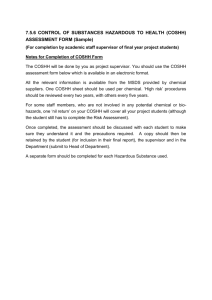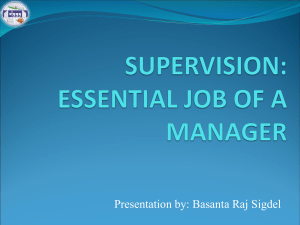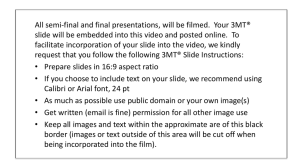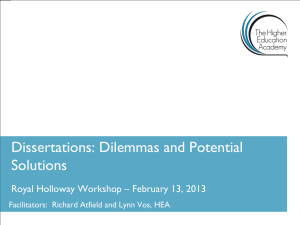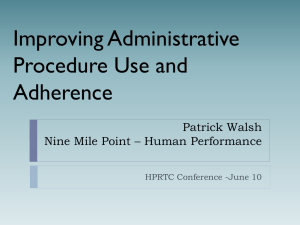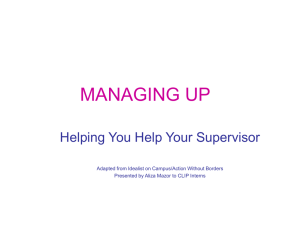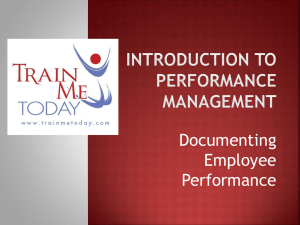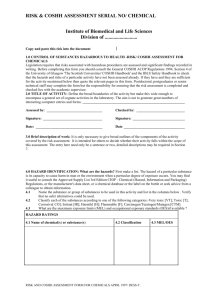Postgraduate Induction - Queen`s University Belfast
advertisement
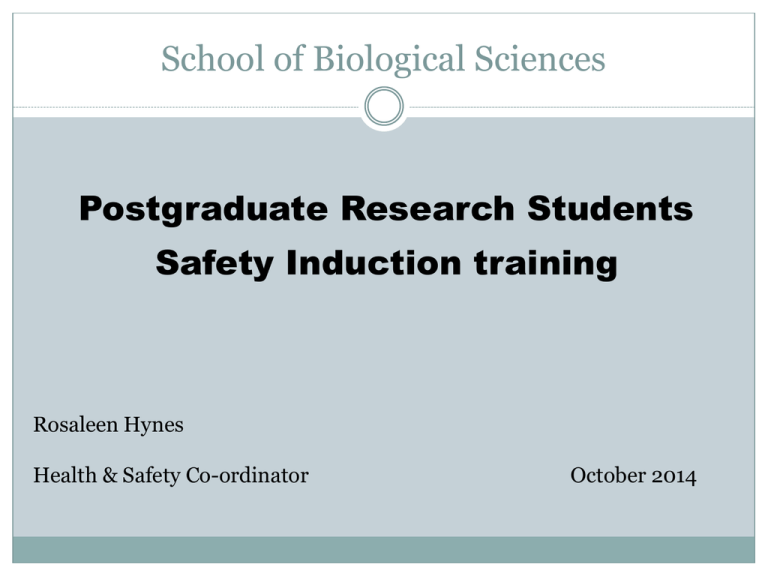
School of Biological Sciences Postgraduate Research Students Safety Induction training Rosaleen Hynes Health & Safety Co-ordinator October 2014 What’s this about? • Legal responsibilities – Queen’s & Yours • Your reporting structure for H&S • How to deal with accidents and emergencies • Fire safety • H&S issues for postgraduates • Personal Protective Equipment • Fitness to Work Legislation to Protect You The Health & Safety at Work (NI) Order 1978 Places duty on Employer to minimise risks H&S Regulations and Guidance Notes COSHH 1994 - Risk assessments (Employers & Employees) Manual Handling First Aid Radiation Legislation to Protect Others Anti-Terrorism Crime and Security Act 2001 Police to be supplied with details of research with potential for terrorist use. Work with certain substances/agents (Schedule 5) closely monitored Security clearance required for personnel working with Schedule 5 material Genetically Modified Organisms (Contained Use) Regulations 2001 All GM work registered with HSE (NI) All GM work risk assessed Potentially hazardous projects cleared with HSE (NI) Legal Regulations set out requirements Non-compliance Risk of criminal prosecution, HSE(NI) Inspectors, Belfast City Council Inspectors Queen’s public image damaged Civil claims Queen’s H&S Responsibilities Queen’s University Safety Policy ‘It is the University’s policy to ensure, so far as is reasonably practicable, the health, safety and welfare of all its staff and students...’ The Vice-Chancellor Professor Patrick Johnston Reporting structure within the School Ultimate responsibility: The Vice Chancellor & Senate School responsibility: Professor C Maggs Head of School Supervisors Laboratory Managers & Technicians You Your responsibilities You have a legal obligation to prevent accidents and personal injury to yourself, colleagues and members of the public You are required to co-operate with your Supervisor in matters of H&S You must not intentionally interfere with anything provided for the purposes of H&S Emergencies QUB Emergency number 2222 • Queen’s Security staff are First Aid trained • Out of hours - serious First Aid Injury – 999 – (Also contact QUB Security) • City Tower Block & RVH site Emergency number 6666 • Know local emergency number Emergencies Medical emergency: Illnesses, accidents…. • Contact Local First Aider • Familiarise yourself with location of local first aid equipment and qualified first aiders. • First Aid Contact Lists displayed in labs and on all first aid boxes. FIRE! Emergencies FIRE! Know how to raise the alarm (shout Fire/ break glass points) Attend School Fire Safety training Know all Emergency Exit routes Know Assembly points Evacuate immediately no matter what! FIRE On hearing the fire alarm: Immediately evacuate the building by the nearest emergency exit. Do not use the elevator Assemble at the designated assembly point For MBC - Bottom of lawn area in front of building, away from the entrance and off the road (for emergency vehicle access MBC) Do not re-enter the building until you are told to do so by a fire warden or other personnel responsible for fire safety Accident & Incident reporting Report all accidents, even where no treatment is required to supervisor/person in charge or Report accidents a.s.a.p. Accident Recorded by relevant staff Co-operate in documenting what occurred/was witnessed - Accident report maybe required for investigation by University safety services. Report incidents of verbal or physical abuse General H&S issues for postgraduates • Hazards – Due to Field sampling Location (Water, Heights, Adverse Weather) • Due to Nature of Experimental Work – eg. Radiation, Toxic/Flammable Chemicals, Infectious Agents • Lone working • Safe use of work equipment • Slips, trips & falls/ manual handling • Safe use of computers • Fitness to work Project work Supervisors’ H&S responsibilities Supervisors are responsible for ensuring all projects are properly risk assessed, documented and comply with H&S requirements: COSHH, radiation, GMO etc. Supervisors must ensure students complete risk assessments. Risk assessments should be completed before commencing work. RISK ASSESSMENTS: Assess Risk: 1. Identify hazards 2. Devise working procedure to minimise risk Risk = Hazard x Likelihood Record Risk Assessment Risk Assessments only required where there are identified hazards RISK ASSESSMENTS: COSHH – hazardous chemical substances and/or carcinogens, mutagens – COSHH Adviser – Mr George Allen COSHH – hazardous biological agents - Specific guidelines within QUB for work with biological materials, infectious agents and GMOs - Biological Adviser – Dr Alan Trudgett GMO – All GM work registered with HSE (NI) - requires approval from within QUB – Discuss with Supervisor GMO Induction on school safety webpage – Consult with Supervisor for guidance RISK ASSESSMENTS: Radiation – Radiation Adviser - Dr K Panov Must be registered for work within the school Lab bench training provided and recorded COSHH RA required Where do you get a COSHH RA form? Blank COSHH RA with guidance notes - School safety webpage, George Allen or myself RISK ASSESSMENTS: Fieldwork – Environmental/Fieldwork Adviser - Mrs G. Riddell Generic Fieldwork RAs with guidance notes– School safety webpage – tailor to your own situation – exclude irrelevant details Visit the site before completing the RA Complete Health & Safety Questionnaire – held by Supervisor in confidence or consult with University doctor Permission for Lone Working - authorised by Supervisor Supervisor’s responsibility to check if health surveillance required eg. Exposure to asthmagens – consult with University doctor RISK ASSESSMENTS: All risk assessments should be completed under the guidance of your supervisor and then submitted electronically to the appropriate school safety adviser. Approved risk assessments should be signed and copies retained by those carrying out the procedure, their supervisor and the appropriate school safety adviser. Project work Supervisors’ H&S responsibilities Supervisors are responsible for: Providing suitable and sufficient training and instruction Ensuring you are competent and understand risks & controls Providing appropriate supervision to ensure you are following the correct procedures Lone Working / Out-of-hours working Hazardous work Sign out of hours book at porter’s desk – after 6pm and at weekends Permission to Work Alone Form - Authorised by supervisor/HOS Includes Declaration of Medical Fitness relevant to work – Held in confidence by supervisor – Inform Supervisor of medical conditions relevant to role eg. Temporary ill health/Migraines, Back injuries, Pregnancy Option to discuss with University Doctor in confidence Safe system of work in place – Addressed in RA Consideration of emergency measures Examples of hazardous work: Work with dangerous machines, dangerous chemicals, poisons, explosives, dangerous pathogens, ionising & non-ionising radiation, cryogenic materials Safe use of work equipment QUB approved equipment only School responsible for maintenance & testing Report defects Switch off after use Slips, trips and falls Prompt cleaning of spillages No tripping hazards, such as trailing leads Reporting of defects in floors and stairs Suitable footwear Save your spine Does this lifting need to be done? Can you make it safer before you do it? Do you need equipment? e.g. trolleys, steps Do you need help? e.g. team lift Can you store at an easier height? Do you need protective wear? e.g. gloves Personal Protective Equipment and clothing Funded by School Laboratory coats Aprons & overalls Gloves Safety footwear Weatherproof clothing Personal Protective Equipment and clothing Safety Service funding Hearing protection (earmuffs, earplugs) Eye protection (visors, goggles, safety glasses) Respiratory protection (masks, respirators, face-fit testing) Prescription safety glasses (on approval) Glasses specifically for computer work Safety footwear subsidy available Safe use of computers Proper workstation set-up Appropriate computer equipment Appropriate furniture, adjustable chair Suitable lighting / no glare Breaks in activity, 5 minutes per hour Report health effects: pains in hands, wrists, arms, neck, shoulders or back Eye discomfort, headaches Need advice? Points of contact within School • Supervisor • H&S Co-ordinator – Dr Rosaleen Hynes • COSHH Adviser – Mr George Allen • Radiation Protection Adviser – Dr Kostya Panov • Biohazards/GMO Safety Adviser – Dr Alan Trudgett • Environmental/Fieldwork Adviser – Mrs Gillian Riddell • School Safety Webpages – School Safety Manual Summary Contacts QUB Emergency Contact 2222 National Emergency Contact 999 Local First Aider first aid box Fire Action Raise alarm Sign in after hours and at weekends University Occupational Health & Safety Services www.qub.ac.uk/uhs safety@qub.ac.uk
